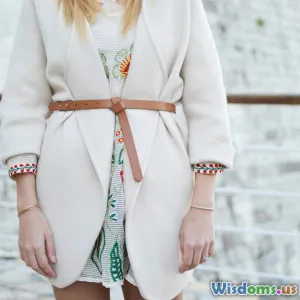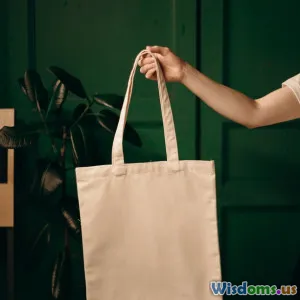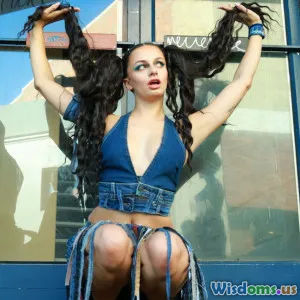
Circular Fashion Explained How Clothes Can Live Multiple Lives
10 min read Discover circular fashion and how clothes can be reused, recycled, and redesigned to reduce waste and extend their lifecycle. (0 Reviews)
Circular Fashion Explained: How Clothes Can Live Multiple Lives
Imagine a world where your favorite shirt or jeans never truly ends up in a landfill but instead cycles through many lives—worn, repaired, transformed, and loved again by others. This vision is at the heart of circular fashion, a revolutionary approach that challenges traditional linear clothing consumption: buy, wear, discard.
Introduction
Fast fashion's convenience and low cost come at a massive environmental and social cost. Globally, the fashion industry generates about 92 million tons of textile waste annually, while only about 12% of textiles are recycled. Clothes often have a life span less than a year, contributing to overflowing landfills and pollution.
Circular fashion aims to rewrite this narrative by designing clothes and systems that keep garments in use for as long as possible. It emphasizes principles such as reduce, reuse, repair, and recycle, creating a resilient, sustainable cycle for textiles.
In this article, we dive into the core elements of circular fashion, its real-world applications, innovations making it possible, and how consumers can participate in breathing new life into their wardrobes.
What is Circular Fashion?
At its core, circular fashion is an extension of the circular economy model, tailored for the apparel industry. Unlike the traditional linear model —
Take → Make → Dispose
circular fashion envisions:
Design → Use → Reuse/Repair → Recycle → (back to Design)
It’s a system where the value of products and materials is maintained, waste is minimized, and resources are continuously circulated.
Key Principles of Circular Fashion
- Design for Longevity: Brands create durable, timeless pieces rather than fleeting trends.
- Resource Efficiency: Reducing water, chemicals, and energy use during production.
- Product Lifecycle Extension: Encouraging repair, cleaning, and resale to prolong use.
- Material Recovery: Recycling fibers into new textiles instead of dumping or incinerating.
Catherine Weetman, author of A New Textile Economy, argues that moving towards circularity requires “rethinking the fashion lifecycle to conserve resources, reduce impact, and redefine value to both business and consumers.”
How Clothes Can Live Multiple Lives
The circular fashion journey involves several practical actions that allow clothes to transcend a single use. Here are the most common and impactful avenues:
1. Secondhand Markets and Resale Platforms
Before a garment becomes waste, it can find a new owner. The rise of secondhand shopping platforms like Depop, ThredUp, and The RealReal showcases demand for pre-loved apparel.
- In 2022, the global secondhand clothing market was valued at approximately $37 billion and is projected to double by 2029.
- Reselling clothes delays entry into the waste stream and reduces demand for new garment production.
Example: Patagonia's Worn Wear program buys back used gear, refurbishes it, and resells, aligning economic incentives with sustainability.
2. Clothing Repair and Upcycling
Instead of discarding garments with minor flaws, repairing or creatively upcycling them can dramatically extend their lifespan.
- Repair cafes and specialized tailors offer fixes ranging from patching holes to zipper replacements.
- Upcycling transforms old garments into new fashion, like turning a worn-out shirt into a tote bag or patchwork jacket.
Japanese brand Kapital exemplifies upcycling by incorporating vintage denim and fabrics into new collections.
3. Rental and Subscription Services
Clothing rental offers temporary wardrobe variety without ownership.
- Platforms like Rent the Runway and Le Tote enable consumers to rent items for events or everyday wear.
- This model reduces total production by maximizing garment use across multiple users.
4. Recycling Textiles into New Fabrics
Recycling breaks down old textiles to create yarns and fabrics.
- Mechanical recycling: shredding textiles into fiber, often resulting in lower-quality fibers.
- Chemical recycling: advanced methods that preserve fiber quality, suitable for materials like polyester.
Brands like Levi’s utilize denim recycling programs to create collection lines from discarded jeans.
5. Designing Modular and Multipurpose Garments
Some innovators focus on creating garments that can be disassembled for repair or redesigned for various styles.
- For instance, Ecovative designs garments with detachable parts allowing users to transform or upgrade pieces.
Industry Innovations Driving Circular Fashion
Circular fashion is more than theory; it’s a fast-growing field of innovation, technology, and business models.
Bio-Based and Recycled Materials
Materials like organic cotton, hemp, Tencel (from eucalyptus), and recycled polyester reduce dependence on virgin, resource-intensive fibers.
- Companies such as Bolt Threads are developing bioengineered silk — a sustainable alternative based on yeast fermentation.
Closed-Loop Supply Chains
Brands are designing clothes with end-of-life recovery in mind, gathering worn products to feed fiber regeneration.
- Eileen Fisher runs a Renew program where returned clothes are repaired or transformed into new garments.
Digital Platforms Empowering Consumers
Apps help consumers track garment origins, repair tips, and resell items, increasing transparency and engagement.
- Good On You rates brands on sustainability, guiding choices that support circularity.
Government and Policy Incentives
Several countries are implementing policies to encourage circular textile economy.
- France requires companies to provide repair information and mandates recycling targets.
- The EU is advancing the Circular Textile Initiative to set standards and fund circular innovations.
The Consumer’s Role: How You Can Help Clothes Live Multiple Lives
Transitioning to circular fashion involves conscious choices at the individual level:
1. Buy Better: Invest in Quality and Timeless Style
Avoid impulse buys and fast fashion. Instead, choose garments constructed with durable materials and classic designs that stay relevant.
2. Care and Repair
Follow care label instructions to prolong garment life and learn basic repair skills. Small fixes can prevent unnecessary disposal.
3. Participate in Clothing Swaps and Donate Thoughtfully
Swap clothes with friends or local events. Donate items in good condition to charities or specialized recycling centers.
4. Support Circular Brands and Platforms
Choose brands embracing circular principles and use resale or rental services.
5. Advocate and Educate
Spread awareness about the downsides of fast fashion’s linear model and the benefits of circularity.
“Washing a shirt less and wearing it more often has a bigger environmental impact than whether the shirt is made organically or conventionally grown,” notes sustainability expert Kate Fletcher.
Conclusion
Circular fashion offers a transformative alternative to the rampant waste and unsustainable practices of the traditional apparel industry. By enabling clothes to live multiple lives through reuse, repair, resale, rental, and recycling, we not only preserve precious resources but also shape a resilient fashion future.
This model requires cooperation—from designers creating long-lasting garments to consumers adopting mindful habits and policymakers incentivizing sustainable practices. As awareness and innovation advance, circular fashion is turning from idealistic concept into practical reality.
Embracing circular fashion empowers us all to rethink our relationship with clothing—not as disposable products but as valuable assets deserving of care, creativity, and multiple stories. Every garment saved from the landfill is a step toward a healthier planet and a more ethical industry.
Invoke the potential in the clothes you already own and explore options that extend their journey—you might be surprised how vibrant the next chapter of your wardrobe can be!
Rate the Post
User Reviews
Popular Posts




















